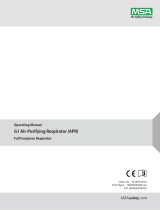
INSTRUCTIONS FOR USE AND CARE
1. An adequate respiratory protection
program must include knowledge of
hazards, hazard assessment, selec-
tion of proper respiratory protective
equipment, instruction and training in
the use of equipment, inspection and
maintenance of equipment, and med-
ical surveillance.
2. This respirator will perform as
designed only if used and maintained
according to the manufacturer’s
instructions. The Program
Administrator and the users must read
and understand these instructions
before using or servicing this product.
3. If the respirator does not perform as
specified in this manual, it must not
be used until it has been checked by
authorized personnel.
4. DO NOT alter, modify, or substitute
any components.
5. Inspect the respirator regularly and
maintain it according to the instruc-
tions. Repairs must only be made by
properly trained personnel.
6. This respiratory protective device
does not supply oxygen. Use only in
adequately ventilated areas which
conform to the appropriate standard.
7. This respirator must be used in con-
junction with the proper chemical or
particulate canister/cartridge(s) for
protection against specific contami-
nants. If you cannot determine that
the filter canister/cartridge(s) used
with this device is designed for the
contaminant, or if you do not know
the identity of the contaminant, do
not use this device.
8. Do not use when concentrations of
contaminants are unknown.
9. Do not use when appropriate expo-
sure limit (PEL, REL, TLV, etc.) is not
known.
10. Leave the contaminated area immedi-
ately if:
a. Breathing becomes difficult
b. Dizziness or other distress occurs
c. You taste or smell the contaminant
d. You experience nose or throat irri-
tation
e. Instructed by responsible individuals
12. Use strictly according to the instruc-
tions, labels, and limitations pertain-
ing to this device. Follow an estab-
lished canister/cartridge(s) change-
out schedule.
13. This respirator may not provide a sat-
isfactory seal with certain facial char-
acteristics, such as beards or large
sideburns, that prevents direct con-
tact between the skin and the sealing
surface of the facepiece. Do not use
this facepiece if such conditions exist.
14. DO NOT wear eyeglasses under the
facepiece. The temples or sidebars
on eyeglasses will prevent an air-tight
seal. If you must wear glasses, install
the spectacle kit.
15. The user must perform a respirator fit
test (Quantitative Test or Qualitative
Test) and follow all warnings and limi-
tations specified.
16. Wear impermeable protective clothing
to prevent exposure to gases and
vapors which can poison by skin
absorption.
17. DO NOT use this full facepiece with
self-contained breathing apparatus
(SCBA).
18. DO NOT use this respiratory protec-
tive device in explosive atmospheres.
19. DO NOT use for urethane paints or
other paints containing diisocyanates
unless an appropriate cartridge
change-out schedule is developed.
Due to their poor warning properties,
over exposure can occur without user
awareness and result in severe per-
manent damage to the respiratory
system. If unable to develop an
appropriate change-out schedule, use
an air-supplied respirator or SCBA.
Failure to follow all warnings, instruc-
tions, and established protective meas-
ures can result in serious personal injury
or death.
TAL 1311 (L) Rev. 24 - 430351
7

























